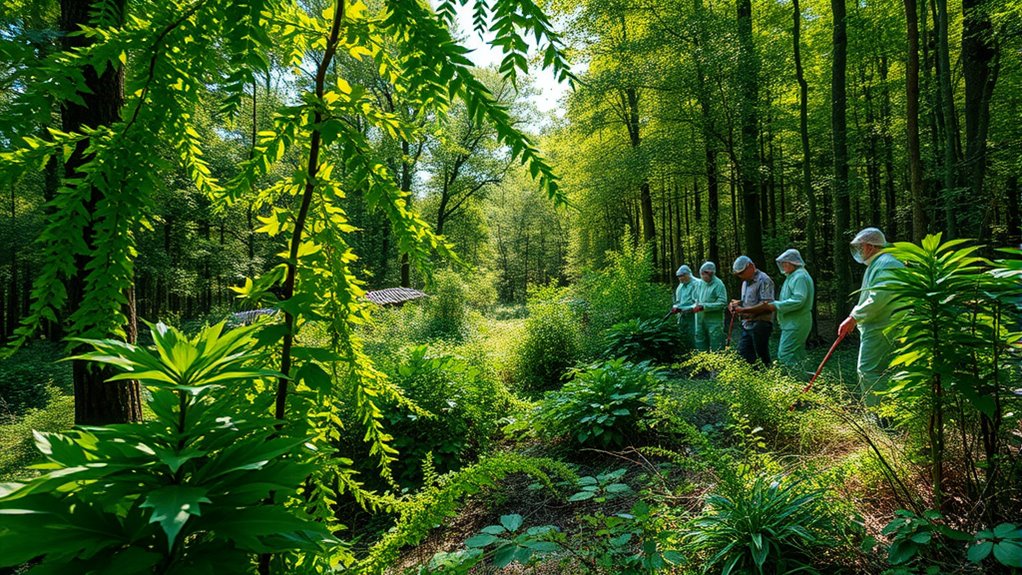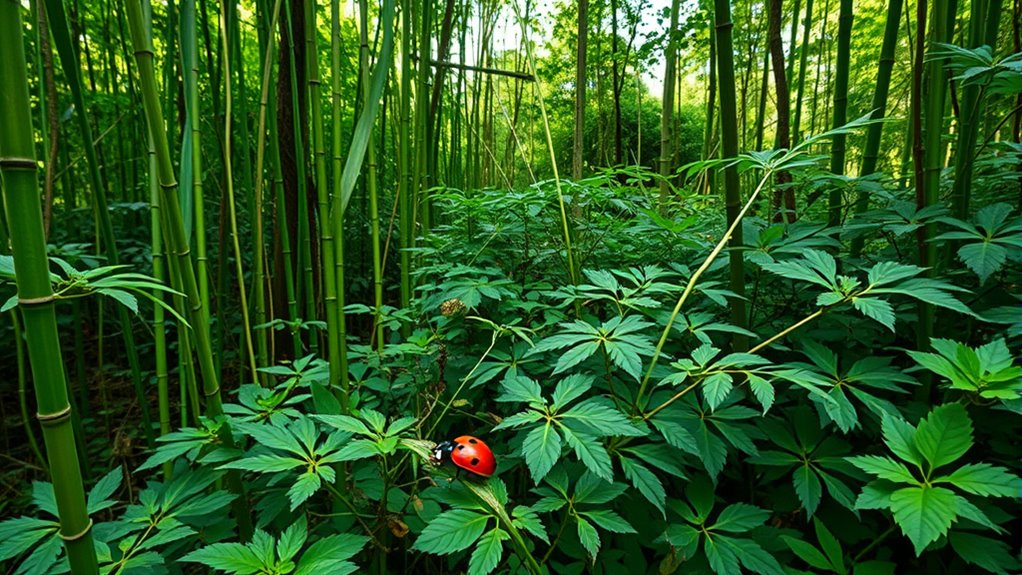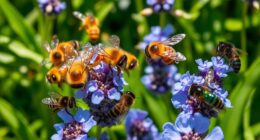Invasive species can have a big impact on ecosystems by outcompeting native plants and animals, which reduces biodiversity and disrupts essential processes like pollination and water filtration. They often arrive through human activities, such as shipping or pet releases, and spread quickly thanks to their reproductive abilities and adaptability. Managing these species involves early detection, control measures, and public efforts. Curious to find out how these invasions can be stopped? Keep exploring to learn more.
Key Takeaways
- Invasive species can disrupt native ecosystems, reduce biodiversity, and alter habitats negatively.
- They often outcompete native species for resources, leading to population declines.
- Some invasive species are introduced intentionally for purposes like erosion control or ornamentation.
- Their rapid reproductive and dispersal abilities enable quick and broad spread.
- Managing invasives requires early detection, control measures, and public awareness efforts.
The Impact of Invasive Species on Ecosystems

Invasive species can dramatically alter ecosystems by disrupting the balance of native plants and animals. When they arrive, they often outcompete local species for resources like food, water, and space. This competition can lead to the decline or extinction of native populations, reducing biodiversity. Some invasives prey on native animals, further destabilizing the ecosystem. Others introduce diseases that native species have no resistance to, causing widespread health issues. Habitat alteration is common, with plants like kudzu smothering trees and changing landscape structures. These changes affect ecosystem services such as pollination, water filtration, and soil stability. In addition, invasive species can interfere with Relationships – Personality Test by affecting the interactions and stability of native communities. The overall result is a less resilient environment, more vulnerable to disturbances and less capable of supporting native flora and fauna. Moreover, invasive species can disrupt biodiversity hotspots, threatening regions with high endemic species and further endangering global biodiversity. They can also introduce novel predators or competitors, which native species have not adapted to defend against, amplifying their negative impact. Additionally, invasive species can hinder restoration efforts aimed at recovering native ecosystems, making management more challenging.
How Invasive Species Are Introduced and Spread

How do invasive species find their way into new environments? Human activities play a major role. They accidentally hitch rides on ships’ ballast water, in shipping crates, or with firewood. Sometimes, people intentionally introduce them for ornamental gardens, erosion control, or biological pest management. Pet owners often release unwanted animals into the wild, allowing species like snakes or fish to escape. Additionally, species can escape from labs, aquaculture facilities, or government programs. Habitat disturbances, such as soil disruption or waterway alterations, create openings for invasives to establish themselves. Once introduced, these species spread rapidly—reproducing and dispersing through natural movement or human-assisted transport—disrupting native ecosystems and outcompeting local species. The reproductive capacity of invasive species, characterized by high reproduction rates, enables them to quickly dominate new habitats and outcompete native flora and fauna. Environmental factors such as climate adaptability further facilitate their spread across diverse regions, making management challenging. The ability of invasive species to outcompete native species often depends on their reproductive strategies and adaptability, which further accelerates their invasion success. Moreover, their rapid dispersal capabilities allow them to colonize new areas quickly, compounding the challenges of control efforts. This combination of human activity and environmental disturbance accelerates their global spread.
Strategies for Managing and Controlling Invasive Species

Managing and controlling invasive species requires a proactive approach that combines early detection with rapid response efforts. You should monitor ecosystems regularly to identify new invasions quickly. Once detected, swift action is essential to prevent spread. You can implement strategies like:
- Mechanical removal, such as physical extraction or cutting invasive plants.
- Chemical treatments to target specific invasive populations.
- Biological control using natural predators or pathogens to reduce invasive numbers.
- Regulatory measures, including import bans, quarantine, and public awareness campaigns.
These methods, combined with habitat restoration and ongoing monitoring, help strengthen native ecosystems. Public involvement is essential—report sightings, avoid releasing pets, and practice responsible firewood and plant handling. Additionally, understanding the impact of invasive species on native biodiversity can inform more effective management strategies. Incorporating cost management principles ensures that these efforts remain financially sustainable while achieving ecological goals. Engaging with cruise lines and other transportation sectors can help mitigate the spread of invasive species across regions. Regular ecosystem monitoring allows for early intervention and reduces long-term control costs. Implementing early detection techniques can further enhance response effectiveness and minimize ecological damage. Together, these strategies form an effective toolkit to manage invasive species.
Frequently Asked Questions
Are Any Invasive Species Beneficial to Native Ecosystems?
Some invasive species can be beneficial to native ecosystems, but it’s rare. You might find cases where they fill ecological roles left vacant by extinct native species or help control other invasive populations. For example, certain invasive plants stabilize soil or provide food for native animals. However, these benefits often come with significant risks, and it’s essential to weigh the ecological impacts carefully before considering any invasive species as beneficial.
How Quickly Can Invasive Species Spread Across Large Regions?
Invasive species can spread swiftly, sometimes sweeping across large regions in just a few years. Their rapid range-riding, relentless reproduction, and resilient resistance allow them to outpace native species and natural barriers. Human activities like shipping, travel, and trade accelerate their advance, propelling pests and plants far beyond their original boundaries. You’ll find that with minimal migration mechanisms, invasives can infiltrate vast territories within a surprisingly short span.
Can Invasive Species Be Completely Eradicated Once Established?
You can’t usually completely eradicate invasive species once they’re established. They often spread quickly and adapt well to new environments, making removal difficult and costly. Even with intensive efforts like mechanical, chemical, or biological controls, some individuals may survive or reappear. Prevention is key, but if invasives are already widespread, managing their impacts and containing further spread become your best options.
What Role Does Climate Change Play in Invasive Species Proliferation?
Climate change accelerates invasive species proliferation by creating warmer, disrupted environments that favor their survival and spread. You might notice that as temperatures rise, invasive species like the emerald ash borer or zebra mussels thrive in new areas where native species struggle. By altering ecosystems, climate change makes it easier for invasives to outcompete, prey on, or introduce diseases to native species, increasing their ecological and economic impacts.
Are Invasive Species a Threat to Human Health and Safety?
Yes, invasive species pose a threat to your health and safety. They can carry diseases that infect humans, like certain fungi or parasites. Some invasive animals, such as snakes or fish, can be dangerous if encountered. Additionally, invasive plants like kudzu can cause accidents by obstructing pathways or power lines. They also disrupt ecosystems, which may lead to reduced resources, affecting your community’s well-being and safety.
Conclusion
You stand at the edge of a shifting landscape, where the quiet invasion of unwelcome species threatens to overrun familiar terrains. By understanding how these intruders spread and employing effective control strategies, you hold the power to protect delicate ecosystems. Imagine restoring balance, like gentle rain nurturing new growth after a storm. Your actions can help turn the tide, transforming a chaotic wilderness back into a vibrant, thriving sanctuary where native species can flourish once more.









